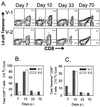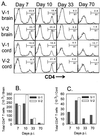Role of viral persistence in retaining CD8(+) T cells within the central nervous system
- PMID: 10933698
- PMCID: PMC112321
- DOI: 10.1128/jvi.74.17.7903-7910.2000
Role of viral persistence in retaining CD8(+) T cells within the central nervous system
Abstract
The continued presence of virus-specific CD8(+) T cells within the central nervous system (CNS) following resolution of acute viral encephalomyelitis implicates organ-specific retention. The role of viral persistence in locally maintaining T cells was investigated by infecting mice with either a demyelinating, paralytic (V-1) or nonpathogenic (V-2) variant of a neurotropic mouse hepatitis virus, which differ in the ability to persist within the CNS. Class I tetramer technology revealed more infiltrating virus-specific CD8(+) T cells during acute V-1 compared to V-2 infection. However, both total and virus-specific CD8(+) T cells accumulated at similar peak levels in spinal cords by day 10 postinfection (p.i.). Decreasing viral RNA levels in both brains and spinal cords following initial virus clearance coincided with an overall progressive loss of both total and virus-specific CD8(+) T cells. By 9 weeks p.i., T cells had largely disappeared from brains of both infected groups, consistent with the decline of viral RNA. T cells also completely disappeared from V-2-infected spinal cords coincident with the absence of viral RNA. By contrast, a significant number of CD8(+) T cells which contained detectable viral RNA were recovered from spinal cords of V-1-infected mice. The data indicate that residual virus from a primary CNS infection is a vital component in mediating local retention of both CD8(+) and CD4(+) T cells and that once minimal thresholds of stimuli are lost, T cells within the CNS cannot survive in an autonomous fashion.
Figures





Similar articles
-
Contributions of CD8+ T cells and viral spread to demyelinating disease.J Immunol. 2000 Apr 15;164(8):4080-8. doi: 10.4049/jimmunol.164.8.4080. J Immunol. 2000. PMID: 10754301
-
Inverted immunodominance and impaired cytolytic function of CD8+ T cells during viral persistence in the central nervous system.J Immunol. 1999 Sep 15;163(6):3379-87. J Immunol. 1999. PMID: 10477608
-
The art of survival during viral persistence.J Neurovirol. 2002 Dec;8 Suppl 2:53-8. doi: 10.1080/13550280290167884. J Neurovirol. 2002. PMID: 12491152
-
MHV infection of the CNS: mechanisms of immune-mediated control.Viral Immunol. 2001;14(1):1-18. doi: 10.1089/08828240151061329. Viral Immunol. 2001. PMID: 11270593 Review.
-
CD8 T cell mediated immunity to neurotropic MHV infection.Adv Exp Med Biol. 2001;494:299-308. doi: 10.1007/978-1-4615-1325-4_46. Adv Exp Med Biol. 2001. PMID: 11774484 Review. No abstract available.
Cited by
-
Chemokine CXCL10 and Coronavirus-Induced Neurologic Disease.Viral Immunol. 2019 Jan/Feb;32(1):25-37. doi: 10.1089/vim.2018.0073. Epub 2018 Aug 15. Viral Immunol. 2019. PMID: 30109979 Free PMC article. Review.
-
The roles of microglia in viral encephalitis: from sensome to therapeutic targeting.Cell Mol Immunol. 2021 Feb;18(2):250-258. doi: 10.1038/s41423-020-00620-5. Epub 2021 Jan 12. Cell Mol Immunol. 2021. PMID: 33437050 Free PMC article. Review.
-
Neurobiology of coronaviruses: Potential relevance for COVID-19.Neurobiol Dis. 2020 Sep;143:105007. doi: 10.1016/j.nbd.2020.105007. Epub 2020 Jul 2. Neurobiol Dis. 2020. PMID: 32622086 Free PMC article. Review.
-
Functional diversity of chemokines and chemokine receptors in response to viral infection of the central nervous system.Curr Top Microbiol Immunol. 2006;303:1-27. doi: 10.1007/978-3-540-33397-5_1. Curr Top Microbiol Immunol. 2006. PMID: 16570854 Free PMC article. Review.
-
Ethanol-Induced TLR4/NLRP3 Neuroinflammatory Response in Microglial Cells Promotes Leukocyte Infiltration Across the BBB.Neurochem Res. 2016 Feb;41(1-2):193-209. doi: 10.1007/s11064-015-1760-5. Epub 2015 Nov 11. Neurochem Res. 2016. PMID: 26555554
References
-
- Ahmed R, Gray D. Immunological memory and protective immunity: understanding their relation. Science. 1996;272:54–59. - PubMed
-
- Aloisi F, De Simone R, Columba-Cabezas S, Penna G, Adorini L. Functional maturation of adult mouse resting microglia into an APC is promoted by granulocyte-macrophage colony-stimulating factor and interaction with Th1 cells. J Immunol. 2000;164:1705–1712. - PubMed
-
- Aloisi F, Rea F, Adorini L. Regulation of T cell response by CNS antigen-presenting cells: different roles for microglia and astrocytes. Immunol Today. 2000;21:141–147. - PubMed
-
- Bergmann C C, Dimacali E, Stohl S, Wei W, Lai M M C, Tahara S, Marten N. Variability of persisting MHV RNA sequences comprising immune and replication relevant domains. Virology. 1998;244:563–572. - PubMed
-
- Bergmann C C, Altman J D, Hinton D, Stohlman S A. Inverted immunodominance and impaired cytolytic function of CD8+ T cells during viral persistence in the CNS. J Immunol. 1999;163:3379–3387. - PubMed
Publication types
MeSH terms
Substances
Grants and funding
LinkOut - more resources
Full Text Sources
Research Materials

